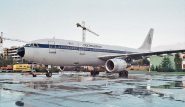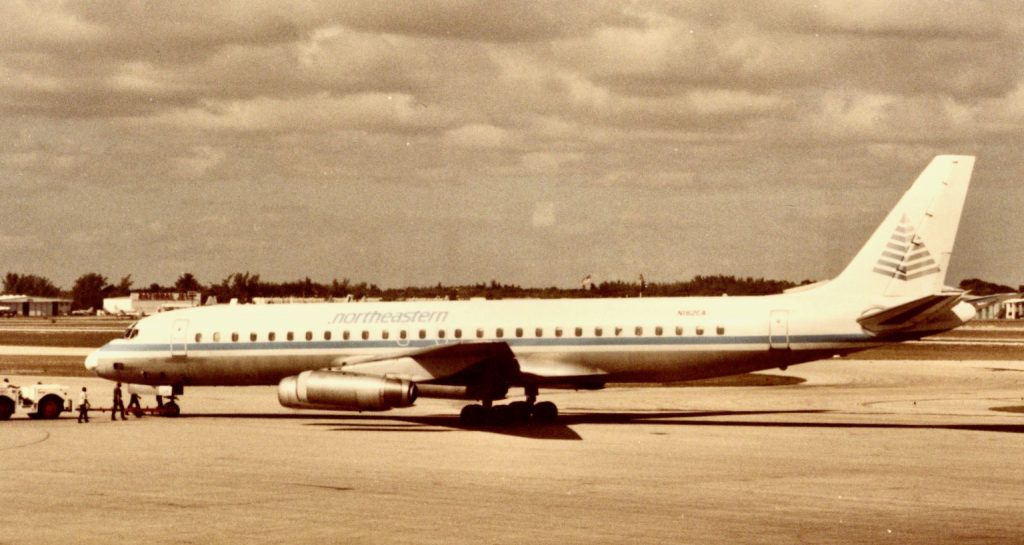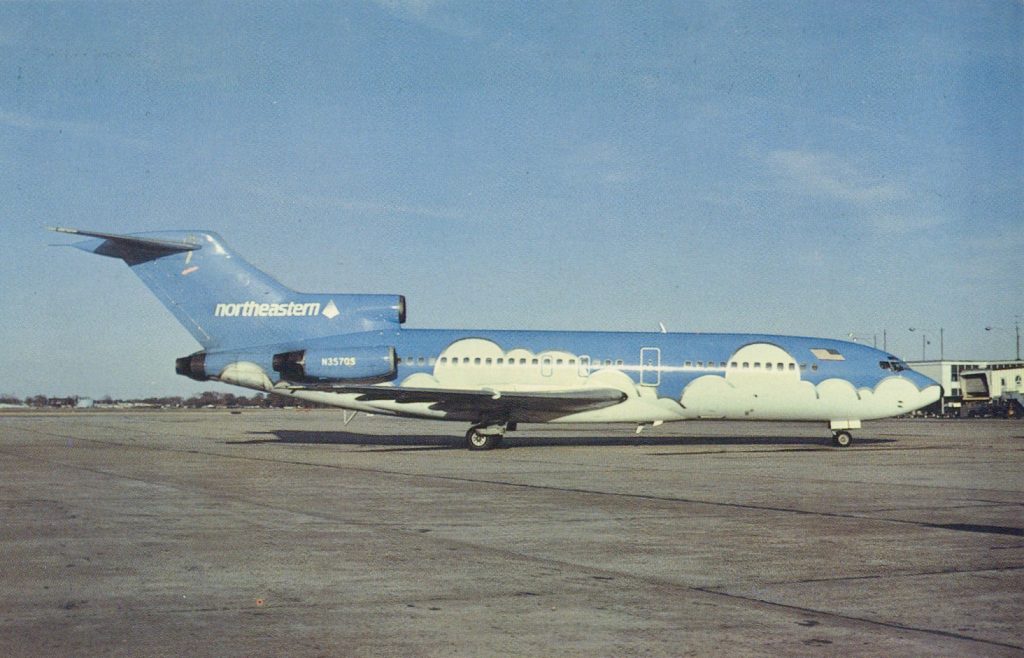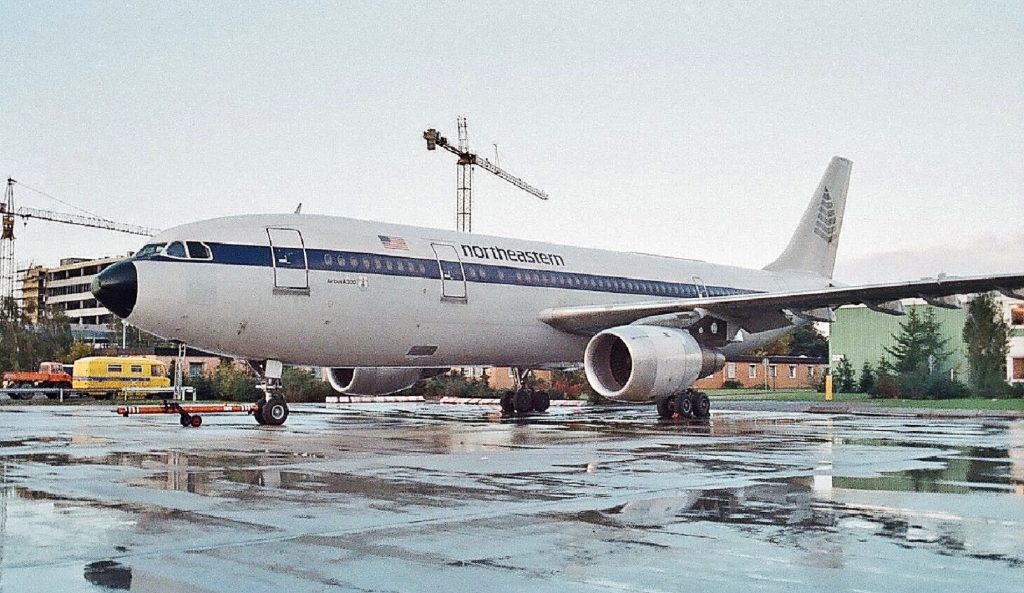
The History of Northeastern International Airways
Written by Robert G. Waldvogel
Its four-year reign was brief and tumultuous, with a high point representing what could have steadily been if ambitions had not exceeded expenses. Yet, perhaps this carrier’s greatest legacy is that it sparked one of Long Island MacArthur Airport’s major development cycles, attracting passengers and, ultimately, other carriers, putting the fledging airfield, which had continually striven for identity and purpose, on the map. The airline had the globe-suggesting name of Northeastern International Airways with the unlikely two-letter code of “QS,” although it never stretched further than the West Coast. Its founder was Stephen L. Quinto and his intended goal was to place his footprint on Long Island MacArthur Airport.
One of the airfield’s long-term goals, as revealed by market studies, was the establishment of nonstop Long Island-Florida service to facilitate travel for those wishing to visit their sunshine state- retired parents, and to tap into the tourist trade seeking winter warmth. Airline deregulation, along with Quinto, made both possible.

Leasing a former Evergreen International DC-8-50, registered N800EV, and operating it in a single-class, 185-passenger configuration, he inaugurated Long Island MacArthur (Islip)-Ft. Lauderdale service on February 11, 1982, charging low, unrestricted fares. As an intercontinental aircraft, its relatively low fuel uplift, combined with a full passenger and baggage complement, enabled it to use 5,186-foot Runway 33-Left, from which it climbed out over Lake Ronkonkoma and departed Long Island over its South Shore. Complementary soft drinks and snack baskets of peanuts, cheese and crackers, sandwiches, and fresh fruit were served in the cabin. Checked baggage was included in the fare.
The initial schedule entailed four weekly rotations to Ft. Lauderdale and one to Orlando, although a second aircraft, registered N801EV, made increased frequencies and destinations possible.
In Northeastern’s first year of operations, the airline carried more than 150,000 passengers and ended the period on a high note by transporting a monthly record of 32,075 in December, a figure attributed to weather-caused, Florida-bound flight cancellations at the major New York airports, and the subsequent bus transfer of stranded flyers to Islip.
Quinto attributed his carrier’s initial success to the trusted and proven concepts of service quality and low, unrestricted fares, along with filling a market gap that had been hungry for years. For this reason, Northeastern adopted the slogan of “A lot of airline for a little money” and, because it served its hometown base of MacArthur, the company eliminated the commute to either JFK or La Guardia for eastern Nassau and Suffolk County residents, telling them “We’re one step closer to home.”

Although its corporate headquarters was in Ft. Lauderdale, Long Island remained its operational base. After leasing two 128-passenger former Pan Am 727-100s, which were draped in pink and blue cloud liveries, it offered seven daily departures from Islip to Ft. Lauderdale itself, Hartford, Miami, Orlando, and St. Petersburg, which was a secondary airport to Tampa. Nonstop flights were also offered from the Connecticut airfield.
Low-fare, deregulation-sparked momentum, once initiated, could not be arrested. The following year, which entailed the acquisition of three longer-range DC-8-62s—including N752UA from United Air Leasing, OY-KTE from Thai Airways International, and N8973U from Arrow Air, saw service to 11 destinations and the annual transport of just under 600,000 passengers.

Yet, deviating from its thus far successful strategy and ignoring the tried-and-true “if it ain’t broke, don’t fix it” philosophy, Northeastern elected to tackle the “big boys” at airports such as JFK and acquire widebody aircraft, ultimately operating transcontinental services. The widebodies themselves came in the form of four Airbus A300B2s in 314-passenger single-class, eight-abreast configurations: D-AIAD from Lufthansa in January (1984), D-AIAE from Lufthansa in February, F-ODRD from Airbus Industrie in May, and F-ODRE from Airbus Financial Services, also in May. It became the second US airline after Eastern to operate the European type.
The strategy may have elevated the low-cost carrier with Long Island roots to a big player, but its over-expansion was defeated by insufficient cash flow. Although it had earned $64.7 million in revenues in its fiscal year ended on March 31, 1984, it recorded a $5.2 million loss.
Its non-financial statistics told another story. By the summer, it operated 66 daily flights to 17 US destinations with a three-type, 16-strong fleet, including 727-200s from the likes of Mexicana de Aviación and VASP, and employed 1,600 personnel.
Its June 1984 system timetable encompassed Boston, Ft. Lauderdale, Hartford, Islip, Kansas City, Las Vegas, Little Rock, Los Angeles, Miami, New Orleans, New York-JFK, Oklahoma City, Orlando, St. Petersburg, San Diego, Tulsa, and West Palm Beach.
Yet gravity is not the only element to cause an airborne object to descend, even those with wings. Finances equally provided—or, in this case, nullified—lift, sparking a rapid descent. Another $4.4 million was lost during the third quarter that ended on September 30, 1984 and with it began the survival-mode strategy of eliminating aspects which could no longer be monetarily supported, including the layoff of 450 employees and the return—it was actually a repossession—of the A300 fleet.
Viewing his once rapidly rising carrier as a jigsaw puzzle, Quinto attempted to keep its picture whole without its forcibly removed pieces and replace them with what he could scrounge. Like plugs pulled from Northeastern’s rapid rise, the lights outlining its structure blacked out. Destinations were eliminated, reservation lines were severed, flights were cancelled, bills were not paid, and passengers were left stranded. On January 3, 1985, the three-year, low-cost carrier fell to the same fate as Braniff, filing for Chapter 11 in a Miami Bankruptcy Court with $28 million in assets and $48 million in liabilities.
The last glimmer of hope came at the end of that same year with a $1 million loan and the lease of a single MD-82 from Alisarda, registered HB-IKL. Yet Northeastern’s final light was doused in early 1986, drowned by liquidation, but such was not necessarily the case for the Long Island airport that had spawned it and to which its legacy was left.
Trackback from your site.

